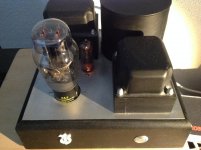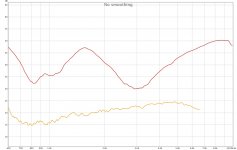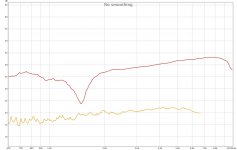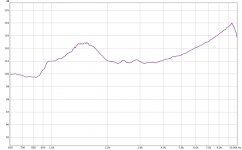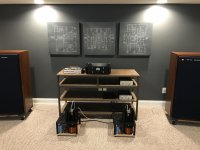My concern is, in the second scheme, C2 should affect the sound quality. One possible solution would be much higher bias supply voltage with 10K bias pot.
Please also check the LTSpice file attached....
Run my prototype with lab psu but in the future i need take care about non compromise CRCLC psu.
Need find the best distortion figure and sound.
That be done but for the moment let's have fun and modify L'Amp again.....
Do you Plasnu bypass your 10000uF with polypro or something ?
Yes, it happened to me once already! Since then, I always power up the amp with Variac...😛
I am affraid about accidentaly disconnection after amp is power up.
Do you Plasnu bypass your 10000uF with polypro or something ?
That Spice model is for simulating the bias circuit, and it is different from my actual amp. My prototype amp has 2x2200uF Panasonic FC + 80uF motor run capacitor. Maybe it's far from ideal, but still good!
BTW, I saw MR's iron amp video again, and I find that the bias section is a black box in this video

It's BYOB 🙂
Thank you, Michael, I have never noticed this article even though I have visited your site 100 times. 🙂
yesterday I visited my friends house where I want to buy his fostex T90a, he is a tube guy indeed. His source is cdpro (i use qls wav player), same dac with me but the different is he has a 4W tube amplifier using high end parts.
He also build OB speaker, fostex 12" fullrange F346 ( I'm using 12" acr & 1.8mH LPF) and he is using the same fostex with mine : FD600&H550 horn tweeter with 4.7uF filter while I use 9uF filter.
I have played several cd from his collection and I can say that my SIT has more coherence, better soundstage and more sparkle. Now I'm a proud man to have SIT L'amp 😀
no plan yet to jump into tube amp world 😉
btw with my OB more than 100dB sensitivity, SIT has more than enough power with 2V output from dac. 25K potentiometer on dcb1 and I never exceeded potentiometer position more than 2 o'clock and it's already damn loud.
He also build OB speaker, fostex 12" fullrange F346 ( I'm using 12" acr & 1.8mH LPF) and he is using the same fostex with mine : FD600&H550 horn tweeter with 4.7uF filter while I use 9uF filter.
I have played several cd from his collection and I can say that my SIT has more coherence, better soundstage and more sparkle. Now I'm a proud man to have SIT L'amp 😀
no plan yet to jump into tube amp world 😉
btw with my OB more than 100dB sensitivity, SIT has more than enough power with 2V output from dac. 25K potentiometer on dcb1 and I never exceeded potentiometer position more than 2 o'clock and it's already damn loud.
Last edited:
proper tube amp is big guy's (with big cojones and same sized brain) territory
let's just say - 1% of all guys making them
percentage is little lighter on side of sand guys ....... say 2.2%

let's just say - 1% of all guys making them
percentage is little lighter on side of sand guys ....... say 2.2%

Tube 2A3 triode i compare with Inductor L'Amp.
Well tubes amp need very high quality output transformers and psu that not the case in my small 2A3 monoblock's.
Sound good but i think tube OTL ( output transformer less )
amp's is much better and have wider band with frequency range.
All simple class A solid state is my favorite
Well tubes amp need very high quality output transformers and psu that not the case in my small 2A3 monoblock's.
Sound good but i think tube OTL ( output transformer less )
amp's is much better and have wider band with frequency range.
All simple class A solid state is my favorite

Attachments
I was trying find why I get more SET-ish sound with choke version than the resistor version. The correlation between THD and speaker impedance would be the reason.
The THD plot of the choke version is similar to those of the tube transformer output amps, and the one of the resistor version is flipped. The sound of resistor version has more resolution, but I do not presume it would be related to these plot.
The attached plot is measurement of the amp output connected to JBL 2450SL driver.
Choke, Resistor, FR. Red is 2nd, Yellow is 3rd.
The THD plot of the choke version is similar to those of the tube transformer output amps, and the one of the resistor version is flipped. The sound of resistor version has more resolution, but I do not presume it would be related to these plot.
The attached plot is measurement of the amp output connected to JBL 2450SL driver.
Choke, Resistor, FR. Red is 2nd, Yellow is 3rd.
Attachments
After carefully listening to those versions today, I think I can conclude this behavior is actually the SET magic that I have been felt.
My theory is this. 2nd harmonic adds glow, makes instruments larger, which makes me feel things are closer to me. However, with choke, the amount of 2nd harmonic is a lot different depends on the frequency position, so something like vocal is moving back and forth depends on the note she sings. This behavior makes me feel she is moving in front of me, more life like, 3D, intimate. But when I play something like clearly recorded piano solo, such as Glenn Gould, I know the grand piano should not be moved back and forth, so I just feel some notes are more exaggerated and pokes out unnaturally. String quartet sounds lively and real as a whole, but it’s very hard to focus one instrument in the quartet, because all of the instruments are randomly moving back and forth.
With the resistor version, the vocals and instruments doesn’t move, it stays on one plane. Probably not deadly still as PP amps, but I can still focus detail of each instrument much better, but vocals are much less life like.
This effect is not really related to the whole amount of the 2nd harmonic. It is clearly heard at most bias positions.
Both sounds really good, just different. I think I will make a switchable version. 🙂
My theory is this. 2nd harmonic adds glow, makes instruments larger, which makes me feel things are closer to me. However, with choke, the amount of 2nd harmonic is a lot different depends on the frequency position, so something like vocal is moving back and forth depends on the note she sings. This behavior makes me feel she is moving in front of me, more life like, 3D, intimate. But when I play something like clearly recorded piano solo, such as Glenn Gould, I know the grand piano should not be moved back and forth, so I just feel some notes are more exaggerated and pokes out unnaturally. String quartet sounds lively and real as a whole, but it’s very hard to focus one instrument in the quartet, because all of the instruments are randomly moving back and forth.
With the resistor version, the vocals and instruments doesn’t move, it stays on one plane. Probably not deadly still as PP amps, but I can still focus detail of each instrument much better, but vocals are much less life like.
This effect is not really related to the whole amount of the 2nd harmonic. It is clearly heard at most bias positions.
Both sounds really good, just different. I think I will make a switchable version. 🙂
Last edited:
I think I will make a switchable version. 🙂
Amazing idea Plasnu
but can be tricky to made in real situation
beacause different biases and psu voltages ?
Amazing idea Plasnu
but can be tricky to made in real situation
beacause different biases and psu voltages ?
Well, that is the problem. I think I can just make a resistor version, and switchable choke (and cap?) insertion after the series of the resistors. It is totally waste of energy, though. 😛
BTW, in my previous post, I said choke - resistor combination sounds good, but after careful examinations, I found it was due to my prototype PSU connection error. It's nonsense, sorry for the confusion. I can't hear any notable difference after fix, except adding extra resistors to choke makes the amp a few dB noisier due to resistor noise.
About R an L sound differences, apart from Harmonic Distortion and PSU noise, I can add damping factor in determining some sonic difference. All those parameters in unison will play the role. This is why is so hard to determine the sonics from charts 🙂 (even so, I love to make all measurements I can)
In practice, the resistor version will parallel the SIT drain AC resistance with resistor, lowering output impedance.
In practice, the resistor version will parallel the SIT drain AC resistance with resistor, lowering output impedance.
About R an L sound differences, apart from Harmonic Distortion and PSU noise, I can add damping factor in determining some sonic difference. All those parameters in unison will play the role. This is why is so hard to determine the sonics from charts 🙂 (even so, I love to make all measurements I can)
In practice, the resistor version will parallel the SIT drain AC resistance with resistor, lowering output impedance.
Yep, I had to add EQ to match each version's frequency response when comparing them. More so for the choke version, as you said. 🙂
I think I'll prototype the common drain version of this amp, which has lower output impedance, but I need a gain stage first...😱
I modified one channel of my prototype L'amp to the common drain version with choke. Gain device is, well, OPA637, please don't blame me, I remembered it was sitting in the junk box. 😱
I'm listening to it now, it's a very different sounding amp. Woofer sounds like a different woofer. 😱
I'm listening to it now, it's a very different sounding amp. Woofer sounds like a different woofer. 😱
I was going to cannibalize them, but they sound so good I'm having reservations.
DIYers dilemma. 🙂
DIYers dilemma. 🙂
- Home
- Amplifiers
- Pass Labs
- L'Amp: A simple SIT Amp
